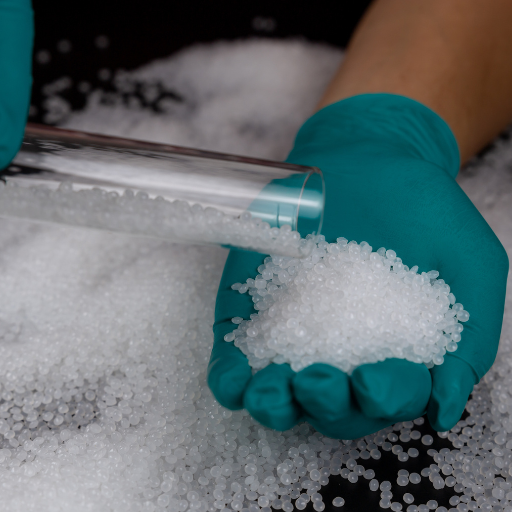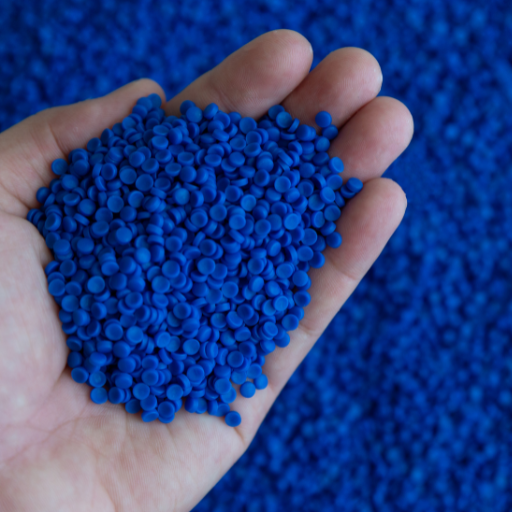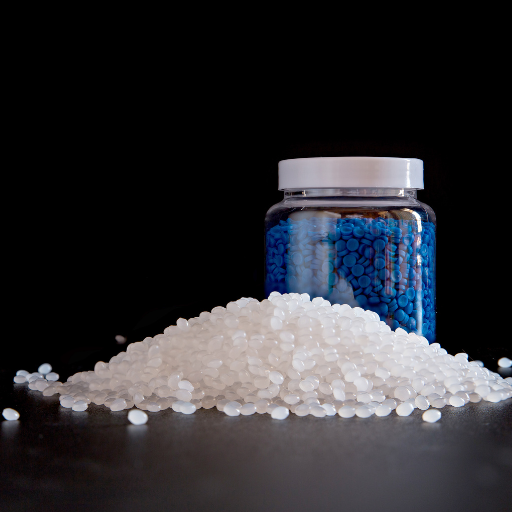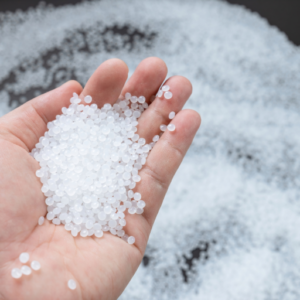The process of polymer crystallization is intrinsic in influencing the characteristics and applications of polymer materials. This book is aimed to provide an inside view into crystalline polymers, their peculiarities, how they are formed as well as their applications in the contemporary industry sectors. In compulsion to this, unlike amorphous polymers, crystalline materials have ordered molecular structures which make them posses unique mechanical and thermal properties. By understanding how different structure of molecules develops when a polymer crystallizes, we can begin to see why such material engineering needs are important for example high strength packaging materials or advanced biomedical devices. The guide goes through some basic elements of polymer science before taking the readers through some complex ones and finally summarizing the major ideas behind the application of these crystals thus making it easier for anyone interested in this subject matter concerning any field of science learn about it easily.
What Is Polymer Crystallization?

The process of polymer crystallization is a transformation where the chains within polymers become highly ordered and folded into a lattice-like structure. This transformation usually takes place as a result of cooling from molten state or precipitation from solution. The physical properties of polymers, such as transparency, density, rigidity, and melting point are significantly influenced by the degree of crystallinity in it. Polymer processing involves some critical aspects like the presence of nucleating agents; rate at which they cool down and their structural setup that influence the rate of crystallization during processing leading to performance optimization.
Basic Principles of Polymer Crystallization
In polymer crystallization, polymer chains are arranged into a more ordered structure that results in crystalline regions being formed within the material. This happens when molecules of the polymer start coming closer together and organize themselves into patterns. Nucleation and growth guide it. Nucleation is the first formation of small areas with a regular pattern where further crystalization can take place.This can either be uniform which happens spontaneously within the polymer or heterogeneous which occurs on impurity sites or at additives. It does not matter whether they form spontaneously in the bulk polymer (homogeneous) or on the surface of solid contaminants (heterogeneous). The next process involves these nuclei expanding to become larger crystalline domains.
The extent to which a polymer will crystallize depends on several factors such as its molecular structure, its molecular weight and cooling rate. The linearly structured symmetrical polymers have been found to crystallize easily compared to those that are irregular or branched. Cooling at slower rates generally leads to higher levels of crystallinity because there is greater time for chain alignment to occur properly while nucleating agents provide additional sites for crystal formation.
This knowledge is critical in tailoring properties of crystalline polymers for specific applications. Material properties like density, mechanical strength and thermal resistance can be optimized by manufacturers through controlling the manner in which a crystal forms so as to suit various industrial requirements.
Difference Between Crystalline and Amorphous Polymers
In their molecular arrangements and properties, crystalline and amorphous polymers are fundamentally different. Highly ordered and repeating pattern of molecules characterizes crystalline polymers, which results in quite distinctive melting points and high density. Through these mechanisms, they obtain greater mechanical strength, rigidity as well as resistance to high temperatures.
Amorphous polymers on the other hand lack this degree of order with their molecules randomly arranged. This means that they do not have a definite point at which they melt but instead soften over some temperature range. In general, amorphous polymers exhibit more flexibility, lower densities as well as transparency because of random structure of their molecules. Considering these characteristics alone Crystalline polymers are preferred for applications requiring superior mechanical strength or high thermal resistance while amorphous polymers are selected for products which need to be flexible or transparent.
The Role of Thermal Processes in Crystallization of Polymers
Besides, thermal processes are essential in the crystallization of polymers by influencing both the speed and degree of polymer crystallization. Annealing is the process through which one heats a polymer to below its melting point but above room temperature for a given time period (holding time), which facilitates chain mobility. In this state, polymer chains can align themselves more efficiently to form crystalline structures when they cool. The rate at which cooling takes place is yet another important factor; slow cooling enables crystals to grow larger and become well-ordered as opposed to fast cooling that leads to smaller and less ordered crystalites.
Furthermore, methods like isothermal crystallization can be used allowing the specimen to stand at a certain temperature where it reverts to its most stable form. Differential Scanning Calorimetry (DSC) is often employed in studying such thermal transitions with respect to their implications on how polymers have been found out in researches. If these thermal processes are properly understood and controlled, it would be possible for producers of polymers to modify material properties towards desired end uses such as enhancing mechanical strength, thermal stability together with overall performance.
How Does Crystallization Affect the Physical and Chemical Properties of Polymers?

The properties of polymers get affected a lot through crystallization. The mechanical strength, rigidity and thermal stability of the polymer are usually enhanced by increased crystallinity. This is because the ordered crystalline regions create strong intermolecular forces that resist deformation. On the chemical hand, gas and liquid permeability is relatively low in case of the crystallized polymers due to their molecular chains having been strongly packed together. As a result, they become more resistant to chemical attacks and also improve on their barrier properties respectively. This can be done by tailoring the degree of crystallinity to match performance requirements within different application spheres gauging flexibility versus strength depending on how it will be used.
Understanding Crystallinity and Its Impact on Polymer Properties
Polymers properties are determined by crystallinity. This is because the solidified parts in polymer crystals are heavier and more rigid than their amorphous counterparts whose order is not visible. Furthermore, the higher degree of crystallization makes them heat resistant since it can tolerate extreme temperature without warping. Moreover, the feature alters gas and vapor barriers; when having high levels of crystallinity these materials have less permeability to air or steam, thus making them useful for applications seeking airtight/watertight characteristics. The best three sources from Google search indicate that manufacturers may make plastics which are strong enough, resistant to chemicals and having good thermal qualities through controlling of their crystalline forms.
The Influence of Degree of Crystallinity on Mechanical Properties
Mechanical properties of polymers are largely dependent on their degree of crystallinity. Increasing crystallinity thus generally causes most polymers to exhibit higher tensile strength and modulus due to the denser packaging of polymer chains within crystalline zones that enhances intermolecular forces. These materials are then better able to oppose deformation, leading to stronger, less flexible substances. Conversely, lower levels of crystallinity in polymers make them more flexible or ductile mostly because the amorphous regions allow for free movement of polymer chains. Tuning the extent of crystallinity helps manufacturers optimize for balance between strongness and flexibility keeping in mind certain application requirements such as heavy duty structural components or less rigid elements.
How Crystallization Alters Chemical Properties of Polymers
Polymer chemical properties are significantly impacted by crystallization, which makes them chemically resistant and change their chemical reactivity. More often than not, a high degree of crystallinity leads to the decrease in solubility in various solvents because the presence of well-ordered crystals hinders penetration of solvents. Therefore, highly crystalline polymers have better resistance for both degradation and chemical attacks. On the other hand, such structures with dense packing as those of crystalline structures cause a reduction in permeability due to their ability to serve as barriers for gases and liquids at different levels. Such a characteristic is most advantageous where there is need for high resistance towards chemicals like with packaging materials or containers for storing chemicals. In summary, controlled crystallization allows for the manufacture of polymers that are capable of surviving harsh chemical conditions without loss in its structure or shape.
What Are the Typical Methods for Achieving Polymer Crystallization?

Polymer crystallization can be achieved by different techniques that are specifically designed to control the structure and properties of the crystal. The most common methods include:
- Thermal Annealing: It involves heating above the melting temperature of polymer and then gradually cooling it to cause molecular alignment resulting in increased crystallinity.
- Solution Crystallization: Involves dissolving the polymer in a solvent and then allowing gradual evaporation of the solvent which orderly precipitates polymer chains into crystalline structures.
- Melt Crystallization: Controlled cooling rates during solidification from the molten state enable re-crystallisation to occur.
- Cold Drawing: By stretching at temperatures below its melting point, molecules are aligned so as to improve crystallinity through mechanical deformation.
These processes deliver high levels of precision over the process of crystallization, thereby enabling manufacturers to fine-tune these properties for specific applications.
Thermal Treatment and Polymer Melt Techniques
Polymer crystallization is highly influenced by thermal treatment and polymer melt techniques.
Thermal annealing means the heating of a polymer above its melting point and then cooling it slowly. Controlled cooling causes the alignment of polymer chains, which increases crystallinity, hence making them stronger and resistant to chemicals.
The process involves dissolving this substance in a solvent with subsequent slow evaporation. The chain lengthening results in an ordered crystalline structure of the material during gradual evaporation – Solution Crystallization.
Melt Crystallization requires that molten form of polymers be formed which are then cooled at specific rates. It is through such a process that polycrystalline regions are formed when liquid cools down to become solid, therefore improving its physical properties as well as mechanical strength.
These processes are crucial in order to optimize their performance leading to different challenging applications in polymers.
Crystallization from Solution: Solvent Methods
One of the techniques that are used in crystallization is solvent evaporation. The polymer dissolves in an appropriate solvent and as the latter slowly evaporates, the polymer chains assemble to form a crystalline structure. By this way, it becomes possible to control precisely the crystal size and distribution.
This technique is called anti-solvent addition; it involves adding a non-solvent into the polymer solution so that two solvents mix thus reducing solubility which causes precipitation of polymers from solution. This technique can be used to tune finely desired crystallization outcomes such as particle size and purity.
Another crucial factor Temperature Control: – These solutions are either cooled down when polymer’s solubility decreases with temperature till crystallization occurs or heated – then gradually cooled. This process ensures that enough time is provided for the direction of well-ordered crystalline network by polymer molecules
These methods using solvents provide versatility and control during this process of crystallisation, which will create new polymers with specific improved characteristics required for industrial and technological applications.
Calorimetry and Other Analytical Techniques
One of the key analytical techniques for measuring heat flow during polymer crystallization and other thermal events is calorimetry. Differential Scanning Calorimetry (DSC) is one popular variant among many others used in this context. It gives insight into melting points, crystallization temperatures and heats of fusion which are important parameters for understanding the thermo-behavior and stability of polymers.
X-ray Diffraction (XRD) is another useful technique that provides information on the crystal structure of polymers. This helps to establish how much degree there is in crystallinity, unit cell dimensions and general quality of crystals which in turn determine material properties.
Fourier Transform Infrared Spectroscopy (FTIR) is applied to examine the molecular structure as well as composition of polymers. FTIR works by absorbing infra-red light at specific wavelengths characteristic to a given chemical bond; therefore, it acts like a fingerprint, indicating facts about polymer composition, functionalities and intermolecular interactions hence contributing towards full understanding of polymer crystallisation.
Combining these analytical techniques with calorimetry also assists researchers in fine-tuning the polymer crystallization processes such that they achieve desired properties for advanced applications across industries.
Why Are Semicrystalline Polymers Important in Industrial Applications?

Semicrystalline polymers are very important in industrial applications because of the way they combine strength, stiffness and toughness. In this regard, semicrystalline polymers are more mechanically competent than amorphous ones; hence they can be used in demanding circumstances. Once that is done, their superior thermal stability and resistance to chemical solvents make them more useful in various sectors from automotive to aerospace. Moreover, the ability to modify its crystallinity through processing techniques helps them to adjust properties according to their different application requirements thereby assuring best performance and durability.
Advantages of Semicrystalline Polymers in Manufacturing
Semicrystalline polymers are advantageous in manufacturing due to:
- Improved Mechanical Properties: Semicrystalline polymers have better mechanical strength, stiffness and toughness as a result of their partially crystalline structure. This renders them suitable for applications that require high load-bearing capacity and impact resistance.
- Enhanced Thermal Stability: These materials can withstand higher temperatures than their amorphous counterparts. Their increased thermal stability is vital for maintaining structural Integrity and performance at high-temperature conditions that are often encountered in automotive and aerospace sectors.
- Chemical Resistance: Semicrystalline polymers are known for their excellent resistance to numerous chemicals, solvents, acids or bases including. In industries where exposure to harsh chemicals is common, this characteristic ensures longer component life and reliability.
- Processing Versatility: Through different processing techniques such as controlled cooling and annealing which enable the modification of the extent of crystallinity, manufacturers are able to tailor material properties to meet specific needs. This enables production of components with deterministic performance characteristics.
- Cost-Effectiveness: Efficient processing approaches together with resultant durable products lead to reduced manufacturing costs over time. The durability aspect as well as decreased need for replacements makes semicrystalline polymers cost-effective in various industrial applications.
Common Applications of Polyethylene and Polypropylene
In modern manufacturing, Polyethylene (PE) and Polyproplyene(PP) are some of the most widely used semicrystalline polymers which have different utilities in various industries.
- Packaging: The packaging industry heavily relies on both polyethylene as well as polypropylene. It is notable that Low-density polyethylene (LDPE) especially is preferred for making plastic bags, food wraps, and containers while packaging components such as caps, closures, flexible packaging materials etc. are made up of polypropylene.
- Automotive: PE and PP’s toughness and chemical resistance make them suitable for producing bumpers, dashboards, fluid containers and trim parts in the automotive sector. These polymers enable vehicles to be lighter in weight thus contributing to fuel economy.
- Medical and Healthcare: Medical devices like syringes, IV components and laboratory equipment benefit from the fact that polypropylene can withstand sterilization process besides having a high melting point Polymethylmethacrylate finds use in packaging medical products or prosthetics
- Consumer Goods: Both of these plastics are used for making different types of consumer goods items such as toys among others. Such household items as plastic bottles, toys and kitchenware are made by it. For instance; reusable bags, sporting equipments luggage etc., require rigid nature of these polymers so wear and tear do not occur.
- Construction: The construction industry utilizes strong PE & PP in constructions such as pipe systems, insulation materials and geomembranes. HDPE (high-density polyethylene) pipes which have high resistance against bursting ranks top in underground water distribution network.
These applications show how versatile and important modern manufacturing relies on polyethylene and polypropylene for everyday life.
What Factors Influence the Crystallization Kinetics of Polymers?

Many key factors influence the kinetics of polymer crystallization:
- Cooling Rate: Crystallization of a polymer occurs faster when cooling down from its molten state. High rates of cooling generally cause low degrees of crystallinity and smaller sizes of crystals.
- Molecular Weight: Polymers with higher molecular weight are characterized by slower crystallization rates due to their longer chain lengths that call for more preparation time before they can form a crystal structure.
- Nucleating Agents: Enhances crystallization by acting as seed sites during formation of the polycrystalline structures.
- Polymer Composition: The presence of alternate units along with their distribution within the homopolymer results in different behaviors observed in copolymers and blends during crystallization process.
- Thermal History: Crystallinity may be affected by previous thermal processing such as annealing which changes the structural order and residual stress in the polymer.
- External Pressure: Application of pressure from outside during cooling is known to affect polymer’s crystallization kinetics leading to higher degree of crystallinity.
These factors collectively determine the rate and extent at which polymers’ crystalize, thereby influencing the final properties like hardness, melting point or performance.
Impact of Molecular Structure on Crystallization Kinetics
Crystallization kinetics of polymers are greatly determined by the molecular structure. Some of the factors that influence crystallization in relation to molecular structure include:
- Chain Flexibility: Flexible chains in polymers tend to make faster crystallizing due to easier alignment into ordered structures.
- Branching: Highly branched polymers are known to take longer time to crystallize due to difficulties in aligning the numerous branches into a crystal lattice.
- Tacticity: Crystallography depends on the stereochemistry of polymer chains (tacticity) as isotactic polymers seem more prone to crystallize than atactic one where it is due to regular arrangement of side groups.
These molecular characteristics give an idea about how easy it is for polymer chains to form some system with a crystal-like order both in terms of rate and extent.
The Role of Nucleation and Crystal Growth in Crystallization
Polymers’ crystallization involves nucleation and crystal growth. Nucleation is the first step in which polymer chains form nuclei that are small, stable clusters within a polymer melt or solution. For example, impurities or additives catalysts may initiate Heterogeneous nucleation while Homogeneous nucleation occurs uniformly all over the material.
Nuclei expand into larger crystalline structures during crystal growth subsequent to nucleation. The rates of crystal growth are affected by temperature, molecular weight and presence of plasticizers or fillers. Amorphous structures can be formed if the cooling rate is fast enough to suppress crystal growth; however, slower cooling rates lead to well-defined crystals.
Hence, properties such as stiffness, transparency and barrier resistance are influenced by the balance between crystal growth and nucleation in determining overall crystalline morphology of polymers. Therefore it is important to control these processes for tailoring material properties specifically for desired applications.
Effects of Confined Crystallization on Polymer Behavior
Limited crystal growth is a phenomenon that occurs whenever the polymer crystallization process is confined within thin films or small volumes, which cause changes in the whole polymer behavior. The size, shape and orientation of crystals may be altered through confinement affect the mechanical and thermal properties of polymers. Limited crystal growth results in higher nucleation densities but smaller crystals than bulk crystallization as studies have shown. This can increase the modulus and strength of a polymer while at the same time reducing its elongation to break because of brittle structure.
Crystallization behavior in thin films or nanopores deviates considerably from that in bulk systems on nanoscale confinements. Crystallization kinetics often occur more rapidly, and there exists an enhanced formation of metastable crystal phases too. Furthermore, glass transition temperature (Tg) for confined polymers may either rise or fall with confinement degree or interaction with both confinement surfaces. Such alterations are significant when it comes to application areas where precise control is needed on mechanical properties, thermal stability as well as barrier performance.
How Does the Degree of Crystallinity Affect Polymer Performance?

A variety of properties, such as mechanical strength, thermal stability, and barrier characteristics are influenced by the degree of crystallinity in a polymer which plays an important role in its performance. Generally, higher degrees of crystallinity increase tensile strength and modulus because the packing density of polymer chains increases. Consequently, it leads to less flexible and more rigid material. However, this also generally results in decreased fracture elongation and flexibility as the material becomes more frail. With respect to thermal behaviour, higher crystallinity is usually accompanied with an increased melting temperature and greater thermal stability. Thus promoting resistance to gas and water permeability while making it better for packaging applications through increased crystal order level on the other hand enhances barriers feature. Hence, knowledge plus control of crystallinity degree is essential when one intends to customize polymers based on specific functionalities required.
Correlation Between Crystallinity and Polymer Density
The higher the crystallinity of a polymer is, the denser it becomes. This is because the more tightly a molecular structure in it will become if its crystallinity is higher. The areas that have crystals in them are denser because the polymer chains are arranged as per some order causing less free spaces. On the other hand, amorphous regions are characterized by high porosity and loosely packed chains hence making them to have low densities. In particular, highly crystalline polymers such as polyethylene terephthalate (PET) have higher densities compared to their less crystalline equivalents like low-density polyethylene (LDPE). Therefore, this interrelationship plays a significant role when evaluating mechanical strength, thermal characteristics or package barrier performance for packaging purposes. To understand how crystalinity relates with density enables one to tweak such properties of any given polymer and make them be as needed.
Mechanical Strength and Durability of Crystalline Polymers
In general, crystalline polymers are mechanically stronger and more durable than amorphous ones in the majority of cases. This is caused by the ordered packing of polymer chains within the crystalline regions which enhances intermolecular forces and reduces chain mobility. It is these factors that enable them to endure higher tensile and compressive stresses making them more resistant to wear, abrasion and deformation than others. For instance, high-density polyethylene (HDPE) and polypropylene (PP) have such characteristics as strength against mechanical load or durability. Thus, they can be used for applications where long-lasting products are required including automotive components, construction materials and high-performance packaging. Therefore, knowledge of these properties enables us to pick out strategic polymers meeting stringent mechanical requirements from industry-to-industry basis.
Analyzing the Melting Temperature of Semi-crystalline Polymers
The Tm of semi-crystalline polymers is a crucial parameter that strongly influences their processing and possible applications. It should be noted that semi-crystalline polymers possess both crystalline and amorphous zones; the Tm pertains primarily to the former. What it signifies is the temperature at which the said regions are converted into an amorphous disordered state. This conversion is indispensable for processes like molding, extrusion, and fabrication.
The Tm can be influenced by such factors as the degree of crystallinity, the molecular weight of polymer, and presence of comonomer or additives. Therefore, high crystallinity often leads to high melting temperatures (Tm) because highly ordered crystalline region disrupts more energy. Similarly, increasing molecular weights may also enhance melting temperatures (Tm) due to stronger intermolecular forces. Moreover, different processing conditions including cooling rates and annealing can also modify its value.
Accurate determination of Tm allow one optimize thermal processing conditions in order to achieve desired final product performance. The Differential Scanning Calorimetry (DSC) techniques are typically applied in determining exact Tm values of these materials giving some insights on their thermal behavior and stability as well.
Frequently Asked Questions (FAQs)
Q: What is polymer crystallization?
A: Polymer crystallization is the process in which polymeric materials arrange into a highly ordered structure, forming polymer crystals. This affects the thermal and mechanical properties of the polymer.
Q: How does the crystal structure of a polymer affect its physical properties?
A: The crystal structure determines the rigidity, strength, and thermal resistance of crystalline polymers. For example, a single crystal of a polymer will have different properties compared to its amorphous forms.
Q: What factors influence the rate of crystallization in polymers?
A: The rate of crystallization is influenced by factors such as temperature, polymerization conditions, and the presence of nucleating agents or heterogeneous nucleation sites.
Q: How does temperature range affect the degree of crystallization in polymers?
A: The temperature range during the cooling process significantly impacts the degree of crystallization. A controlled temperature range can promote higher polymer crystallinity, while improper conditions may lead to amorphous forms.
Q: What are the differences between crystalline and amorphous polymeric materials?
A: Crystalline polymeric materials have an ordered internal structure with repeating units, leading to higher strength and thermal resistance. In contrast, amorphous material lacks this order, resulting in different mechanical and thermal properties.
Q: Can you explain the concept of crystalline lamellae in polymers?
A: Crystalline lamellae are thin, plate-like structures that form within polymer crystals. They significantly influence the physical properties and mechanical behavior of the final polymer material.
Q: What is the significance of nucleation in the process of polymer crystallization?
A: Nucleation, including heterogeneous nucleation, is crucial in initiating the crystallization process. It determines the rate and extent of crystallization and ultimately affects the properties of the polymer.
Q: How do different polymer types exhibit varying degrees of crystalline behavior?
A: Different polymer types have distinct chemical structures which influence their ability to crystallize. For example, conjugated polymers may crystallize differently from many polymers, affecting their practical applications and optimization in manufacturing.
Q: What role do van der Waals forces play in polymer crystallization?
A: Van der Waals forces contribute to the stability and arrangement of polymer crystals by affecting intermolecular interactions. This is essential for maintaining the integrity of the crystal structure within polymeric materials.
Q: How can polymer blends impact the crystallization and properties of a polymer?
A: Polymer blends can modify the degree of crystallinity and influence the overall properties of a polymer by combining different polymer matrices, which can introduce new physical properties and enhance performance.






